|
|
Introduction

photo by
Bob
Willoughby |
|
Jean
Tabaud at 42
|
The
following summary of Jean Tabaud's life is based on my forty-year
friendship with
him, which began in Hollywood in 1956, and which lasted until his
death in 1996. It is based on tales he told me, on letters he wrote
to me, on the four manuscripts he left behind (three autobiographical
novels and one memoir), on numerous newspaper articles he authored,
on interviews he gave, on appointment agendas, and diaries he kept,
albeit haphazardly, throughout the years. As well as on other bits
and pieces of information about his life that I found among his
papers, which I inherited as the executor of his estate. He also
left in my care some 300 paintings, drawings, and sketches. And
hundreds of photos of portraits he executed during his lifetime,
some identifiable, but most are not. A few of these can now be viewed
on this website. More will be posted as this site expands.
There
were years when Jean and I didn't see each other. When he was either
traveling in Europe or in various parts of the United States, and
when I was also living in other parts of the world and on other
continents. But we always managed to stay in touch, no matter what
the circumstance. At the very least, a few letters a year passed
between us, even when I was caught in the turmoil of the Congo's
independence from Belgium in 1960. Or, subsequently, when I was
farming on the remote pampas of Argentina and Jean had become a
prominent portrait artist with studios in New York, Paris, St. Moritz,
London, San Francisco.
Beginnings
Jean
Tabaud was born Jean Gilbert Tabaud on July 5, 1914, in the small
town of Saujon, France, on the Southwest Atlantic coast, north of
Bordeaux. He was the son of Lucien Tabaud and Ernestine Tabaud Hillairet.
His father was a butcher by profession, who served in World War
I, where he was wounded and gassed during the conflict.
Jean
remembered his early childhood as being a happy one, helping his
father in his butcher shop. And, when he was old enough, served
as his delivery boy, riding about the countryside on his bicycle,
delivering his father's meats and homemade sausages to the housewives
in the area, who never failed to reward him with a sweet or two.
As an only son, he was adored by his parents, and when not attending
school or helping out in the shop, was allowed to roam as he pleased
over the landscape of the Charente River where it empties into the
Atlantic. Jean had a free, good-natured spirit, an open, candid
smile, sparkling black eyes that exuded good humor and which never
failed to elicit a smile in return from those he met, friend and
stranger alike. He loved to run in the fields and jump walls. He
longed to fly like a bird.
By
the time he was ten, however, his father could no longer support
the pain caused by his war wounds. One evening he invited Jean to
a local restaurant for a celebration dinner, as he called it. When
they returned home, he took off the four-banded gold ring that wound
around the third finger of his left hand in the form of a snake
and handed it to Jean, telling him, "Always wear this. It
belonged to your grandfather and his father before him."
Then he embraced his son, climbed back into his car, and put a bullet
in his head.
Despite this traumatic heartbreak,
Jean's optimistic outlook on life continued. His spirit remained
a free one; his appreciation of nature's beauty, and his adoration
of the human body as a sublime creation, especially the female figure,
never ceased to fill him with wonder.
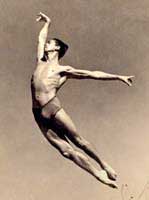 |
| Jean
Dancing |
Following
his father's death, Tabaud's formal education came to a halt. In
his teen years he earned his living selling brooms from door to
door, apprenticed as a picture framer, dabbled in journalism, and
at nights worked as a cloak-room attendant at "La Forge,"
a music hall in nearby Bordeaux. He often wandered backstage, observing
the dancers and envying them their graceful agility, imitating their
routine whenever he could. It was there that he met the famous Belloni,
husband and wife team, who encouraged him to study classical dance
for a year, following the rigorous Cecchetti method. Then the impresario
Lifar came into his life. His first engagement, at the age of 20
in 1934, was with the Comédie Française. Later he
would dance with the Marquis de Cuevas' Grand Ballet Company, and
soon was invited to join the Ballets Russes.
While in Paris he met several artists
- friends of the theatrical crowd with whom he associated. Among
those who particularly impressed him was the Polish artist, Maïa
Berezowjka, and recognizing his natural talent, she encouraged him
to study art. He attended a few classes at the École des
Beaux Arts but he had little time for this as his ballet career
developed into full-fledged stardom for him with the Ballets Russes,
dancing in Paris, Berlin, Geneva, Belgium, Switzerland, Rio de Janeiro,
Tangiers, Casablanca, and Argentina.
But
while performing at the Teatro Colon in Buenos Aires in 1939, he
fell while practicing a particularly difficult dance maneuver, injuring
his spine, and forcing him to give up dancing. He returned to France
to seek treatment for his back but instead met up with the outbreak
of World War II. He was immediately drafted into the French Army,
witnessed the fall of France to Germany, and was taken prisoner
in 1941.
Yet, despite the hardships he suffered,
his ever-present back pain, and the horrors he witnessed, his good
humor and blithe spirit remained intact to the point where his fellow
war-weary prisoners knick-named him "Simplicimus" - the
simple one.
While in the camp, he managed to procure
some paper and crayon, and, to pass the time, began sketching portraits
of his fellow prisoners. One of the German guards, observing this,
asked if he, too, could have his portrait done. The result was so
pleasing to him that soon other guards, as well as the Commandant
of the camp, asked for the same and supplied Jean with all the drawing
materials he needed.
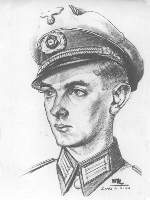 |
| German
Soldier |
One day
in 1942, Jean seized the opportunity to leave the camp, along with
a group of other prisoners, who were assigned to assist local farmers
to bring in the harvest. But he never returned with them. He quietly
slipped away and made his way to Paris, where he found friends who
supplied him with false identity papers. For the next two years
he made his living as a peripatetic artist, in the evenings going
from one café to another, drawing portraits of German soldiers,
sailors, airmen of all ranks, charging but a few francs each. He
plied his trade not only in Paris but traveled to the Normandy coast
and Le Havre - often on bicycle. He returned to Bordeaux, visited
his mother in nearby Saujon, and then went on to Marseilles, Nice,
and the south of France. Then he returned to Paris, always using
the same false identity papers. All the portraits he executed during
this time had to be signed with the name they bore: Juvee.
While
plying his trade at night, Jean sought help for his back during
the day from several Parisian doctors, but without success. Yet,
he continued to practice his classical ballet exercises. Painting
was just a way of earning a living for him until he would be well
enough to resume his dancing career. In 1943 Jean was invited to
join a French troupe, which was asked to perform in Berlin. His
pain was almost unbearable but he managed to execute the most perfunctory
of steps. Soon, however, the bombing became intense, the ravages
of war all about them intolerable, and the company shortly limped
back to Paris.
Meanwhile, Tabaud lived constantly
with the fear that his escape from the prison camp would be discovered.
But the Germans evidently believed he was harmless enough, never
dealing in the black market or suspected of being a member of the
underground. He was useful to them. His subjects ranged from lowly
seamen to high-ranking officers, most choosing to be portrayed in
full uniform, but some did not. Toward the end of the war, Tabaud
was recruited by a German doctor to do the portraits of wounded
and dying soldiers in the Paris hospitals. He preferred these assignments
above all others. These portraits were then sent to their families
back in Germany.
By
the time of Germany's defeat, Tabaud had executed over 5,000 portraits
between 1942 and 1944. During this time he managed to secure a camera
and took photos of the portraits he had done to show to potential
clients. Ninety-five photos of these portraits have survived and
several examples can be seen on this website.
Tabaud
was in Paris when the Germans marched out and the U.S. troops marched
in. This extraordinary period in his life is recorded in detail
in his French memoir of the war years titled, Une Couche de Vie
sur une Tranche d'Histoire. Roughly translated: A Layer of
Life upon a Slice of History.
He remembers having witnessed the
following scene in August 1944, two months after the Allied Forces
landed in Normandy. "In the afternoon I awoke,"
he wrote, "and headed toward the Place Blanche in search
of something to eat. The streets were deserted. All of Paris was
hiding behind shuttered windows and doors, waiting for the Americans
to arrive, terrified by the rumor that Paris had been mined and
would blow up before we were saved. As I turned the corner, I was
astonished to discover a tide of Germans, as far as the eye could
see, filling the boulevards, flowing slowing, silently, upstream
and downstream, like a river."
It was at this time that Jean, forced
to remain secluded in his apartment with his mistress, existing
on only flour and water, drew his first nude. (Nudes would become
one of his favorite subjects from here on and would greatly contribute
to his fame as an artist.)
Then,
Jean's memoir continues, "…It took several more days
for them (the Americans) to arrive, but first came de Gaulle, marching
triumphantly down the Champs Elysées at the head of his Free
French troops…and this time all of Paris was there to greet him…
"The
Americans followed the next day. I was thunderstruck by what appeared
before my eyes: a mass of miserable corpses, mute, silent, surrounded
on all sides by jubilant crowds. They came wearing tattered uniforms
the color of dead leaves. Coming so soon after the stony, granite-like,
impeccably dressed Germans, one would think the Americans fought
the war in their pajamas. And wearing slippers. For if it weren't
for the tanks that accompanied them…one would not take them
for soldiers at all. They marched with a soft step and waddling
gait - barely a military one - in rubber heeled shoes. They did
not make more noise than a caravan of camels."
Morocco, Hollywood,
Mexico
 |
| Jean
in Holllywood with a drawing of Jossee, his favorite model,
in the background |
Following
the end of the war, almost one year later, Tabaud, seeking the sun
and escape from war-torn Europe, traveled to Majorca and then to Morocco,
where he lived for eight years. In Tangiers and Casablanca he established
a school of dance, gave recitals, choreographed ballets, wrote articles
on art and the
dance. During this period he painted many Moroccan landscapes, as
well as studies of the local people. In 1953 he was encouraged to
try his luck in the United States.
He
began in Hollywood, where he was immediately successful, receiving
commissions for portraits from such stars as Charles Boyer, Deborah
Kerr, Pier Angeli, "Zizi" Jeanmarie, to name a few. The
French Ambassador to Mexico, while visiting Hollywood, suggested
an exhibit of his works - particularly his Moroccan landscapes -
in Mexico City. It was met with considerable success and was followed
by two more exhibits. One in Monterrey and one in Acapulco.
New York
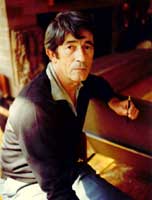 |
Jean
at 56 (1970)
working in his Pauling studio |
Following
several more critically acclaimed exhibits in Los Angeles and San
Francisco, Tabaud moved to New York City in 1957, where he established
his studio at 440 East 79th Street. Over the next ten years he traveled
extensively, executing portrait commissions in the United States
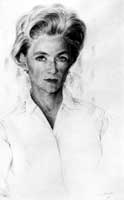 |
Mrs.
John Y. Randolph Crawford
New York, N.Y. |
and Europe of the rich
and famous, as well as the not so
rich nor famous. Among his innumerable clients
were such subjects
as the Mrs. Henry Fords, (both Anne and Christina) as well as Henry
Ford's children, Anne, Charlotte, and Edsel. Mrs. Ted Kennedy, Mrs.
Stavrous Niarchos (Eugénie) and her children. Mrs.Pierre S.
DuPont, Jr., Henry Miller, Lady Sarah Russell, Lady Sarah Crichton
Stuart, Mrs. T. Jefferson Coolidge, Mrs. Clint Murchison, Jr., and
her daughter. Suzy Parker, Peter and Lili Pulitzer and their children,
Mrs. John Warner (daughter of Paul Melon) and their children. John
Kenneth Galbraith, Baroness Fiona von Thyssen, Mrs. Howard Cushing,
Jr., and her children.
 |
| Pyramid
Man |
In
addition to portrait painting, Tabaud experimented with various
schools of art, most notably cubism, and with several different
techniques, such as oil on canvas as well as on board, colored pen,
water colors, pastels, charcoal and pencil, melted crayon with scratched
pen technique, etc. He was strongly influenced by the artists of
the impressionist era, especially Renoir, Monet, Corot, Van Gogh,
and later Modigliani. The influence of Gauguin can be detected in
his Moroccan paintings.
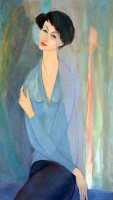 |
| Lady
L |
At
the height of his career, Tabaud executed several paintings under
the name of Leret, but was unsuccessful at marketing them. What
sold was a Tabaud. What clients wanted was a Tabaud and nothing
less. For several years he was featured in Portraits, Inc., in New
York in their annual exhibits of portraits by well-known artists.
His work appeared regularly in their New Yorker and other magazine
ads, as well in their New Year's greetings to their clients, featuring
the portraits he did of the founders of Portraits, Inc., - Lois
Shaw and Helen Appleton Read. These cards sometimes included the
portrait he did of Andrea Erickson Gehringer as well.
By
1968 Tabaud began to tire of the social life his portrait-seeking
commissions demanded of him, and he bought several acres of woods
outside the village of Pawling, New York, where he built his "hideaway."
Most of the house and outbuildings he constructed himself, but still
maintained his studio in New York City, to which he commuted three
days a week, and continued to travel to Europe for three months
out of the year, especially to France where he owned an apartment
outside of Versailles. In 1975 he made a trip to South America,
where he had commissions in Brazil.
 |
Jean
at 80 (1996) outside
his house in Pauling, NY |
He
also visited Argentina and the Teatro Colon in Buenos Aires, where,
thirty-six years before he had had his famous "mishap."
The pain in his back never left him. However, he continued to maintain
contact with the world of ballet, and kept himself in excellent
shape, exercising daily, and following a strict diet of organically
grown foods, supplemented by a wide range of vitamins. In Pawling,
he learned carpentry, built his own furniture, a sundeck for his
house, a woodshed, and a guesthouse hidden away deep in his woods.
Spring, summer, and fall he spent hours clearing the underbrush
in these woods and alongside the steep banks of the delightful,
fast-flowing, boulder-strewn brook that ran through his property.
He harvested his own wood, chopped, split, and corded it for his
fireplace, which burned brightly on chilly days and all through
the winter. If a visitor was lucky enough to be invited for dinner,
he, or most likely she - for Jean never wanted for female companionship
- would be treated to chicken roasted over this fire, and sometimes
a grilled steak.
He enjoyed observing the deer as they
came to feed in the meadow outside his picture windows, and, at
the same time, admiring the wild flowers that grew there in great
profusion. He was fiercely protective of these flowers, considering
them more beautiful than any cultivated rose and scolded the hapless
visitor who inadvertently happened to trample on them. "Please
don't walk on the wild flowers!" he would say. He refused
to use a lawn mower on his property.
It
was only in 1980 that he gave up his studio in New York altogether
and settled permanently in Pawling, traveling but once a year to
France to visit old friends. He had no family. He never had any
children. His mother and older sister - his only sibling - had died.
His closest relative had been her daughter with whom he had lost
touch years before. Jean Tabaud never chose to marry; although,
the number of mistresses in his life were many. There were few women
who could resist his natural charms. And his delightful French accent.
Even after fifty years in the United States, he never lost it. Although
from the French bourgeoisie, Jean had the manners of a highborn
gentleman, and treated each woman he met as though she, too, was
of royal blood.
I
came to the conclusion, after many years, that Jean loved all women
to the extent that he could never commit himself to any one woman
for life. After a period of observation, Tabaud could find something
special in the countenance of each one of his subjects, no matter
how poorly endowed by nature they might seem to the casual observer.
It was not unusual for a woman to exclaim upon completion of her
portrait, "I feel like I have just been made love to!"
In an interview with the New York
Times in 1966, Tabaud is quoted as saying that after he has painted
a woman he knows her better than do her friends of ten years. "To
paint," he said, "is an act of love whether the subject
is a tree or a woman. …A person who feels she is being loved
opens up and you get to know her."
In 1954 the Palm Beach Daily News
reported that "Tabaud makes his revelation of personality radiate
from the source of personal expression, the eyes of his subjects.
The individuality, then, shifts to the treatment of hair, the curve
of lips and, finally, is crowned with poetic precision by a pure
and thin contour line of exquisite delicacy."
 |
| Mexican
Child |
Tabaud
also excelled in painting children. Though he never had any of his
own, he enjoyed painting them. The art critic of the Los Angeles
Examiner said in his review of one of Tabaud's exhibits in 1956,
"I am hard put to recall if I have ever seen more arresting
pictures. It has been three days since I looked at his works and
still their memory lingers in a most pleasing way. Especially the
portraits of little children. He gives their faces marvelous expressions:
as if they are, in a spiritual sense, on the threshold of adult
experiences, as if some unknown force is pulling their thoughts
into a world they would much rather back off from."
Retirement
In
Pawling, Tabaud pleased friends and neighbors by drawing their portraits,
free of charge. Whole days and evenings were spent reading the works
of philosophers whose thoughts he had longed wished to examine but
had never had the time to do so before. It was during this period
that he wrote his World War II memoir and completed the manuscripts
of three novels. All three of which sing praises of, pay homage
to, the beauty of the female form - page after page. Two years after
his death the Village of Pawling changed the name of the winding
dirt road leading to his home from Gristmill Lane to Frenchman's
Lane.
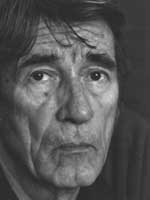 |
| Jean
Tabaud at 82 (1996) |
Jean
spent the last five years of his life battling Lyme disease. But
this debilitating disease was not diagnosed until three years before
his death, when treatment by antibiotics was of little use. By age
79, his hearing began to fail, as well as his eyesight. At 80 he
was diagnosed with cancer of the prostate and underwent major surgery.
This dealt a particularly fierce blow to his self-esteem. At 82,
having been fiercely independent all his life, he was denied a driver's
license. He feared the prospect of ending his days in a nursing
home, costing him most of his considerable, hard-earned fortune.
Thus he made the decision to will all his money to the Maryknoll
Catholic Missions in Peru, in care of my brother, Father Edmund
Cookson. "For the children," he told me and his lawyer,
"where it will do some good."
In the last letter he
ever wrote, dated December 1, 1996 - two days before his death -
Jean Tabaud wrote to Father Edmund Cookson in the Altiplano of Peru
regarding the inheritance he was about to receive:
I trust you do
the best work possible to improve the life of those poor people
and the funds will be used wisely, in a solid practical way.
I like to imagine you standing in the bright sun of a pure
sky, fulfilled by the task of the day. You have a splendid life--
Signed: Jean
Later he made me promise,
"And, please, Elise, no prayers!" Jean had been born a
Catholic, and raised by the Jesuits, but following the death of
his father had never set foot in a church, of any kind, again. Shortly
thereafter, he made his exit from this world, as his father had
done before him: with a bullet in the head.
Despite
my promise, prayers were indeed said for Jean Tabaud by the population
of the distant city of Yunguyo in the Altiplano of Peru, on the
shores of Lake Titicaca. They took the form of a candlelight procession
to the top of the highest surrounding mountain, where a Requiem
Mass was said in remembrance of him. And following this, his photo
was placed in the 16th century cathedral of Yunguyo, which his money
helped to restore, and he is remembered in the daily prayers of
the congregation.
He died December 3, 1996. Eight years
later, when I began my research on his biography, I discovered the
following note among his papers. It was dated October 3, 1996:
For
many years now I have suffered from chronic Lyme disease, which
takes away all my strength. If the day comes when I no longer am
able to assume the chores around the house, rather than pay somebody
to do it for me - etc., etc. - I would chose to save the money for
the people I leave it to. This means that I'll have to die a little
sooner. With satisfaction.
|












